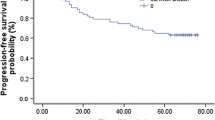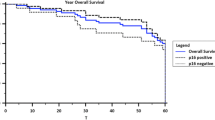Abstract
Background:
The aim of this study was to analyze the prognostic importance of extracapsular nodal spread (ECS) in patients with locally advanced squamous cell carcinoma (SCC) of the oral cavity or oropharynx, and the impact of adjuvant low single dose cisplatin-based radiochemotherapy on distant metastases-free survival (DMFS).
Patients and Methods:
The study population was selected from 195 patients with high-risk oral cavity or oropharyngeal cancer, who had either adjuvant radiotherapy (RT) or radiochemotherapy (RCT) between January 1, 1997 and December 31, 2006, at the University Clinic of Radiation Oncology of the Martin-Luther-University Halle-Wittenberg. A total of 42 matched pairs of patients with UICC stage III–IVa,b disease were analyzed. The patients were matched (one to one) according to tumor site, sex, T stage, N stage, ECS, resection margin status, and Karnofsky performance status. To analyze the correlation between the treatment modality (RT vs. RCT) and the impact of ECS on DMFS, the Cox proportional hazard model was used. Survival rates were calculated using the Kaplan–Meier method.
Results:
There was a strong correlation between the degree of nodal involvement and ECS (pN1: 33%; pN2b: 45%; pN2c: 71%). Moreover, the 5-year locoregional control rates (LC) in patients with ECS were 76% vs. 63% (n.s.) for RT and RCT, respectively. However, for patients without ECS, the LC was more favorable after RCT (RT vs. RCT: 62% vs. 88%, p < 0.05). DMFS again was better after RT, and this observation was independent of the presence or absence of ECS. Finally, in multivariate analyses, the presence of ECS significantly decreased the DMFS (p = 0.04, hazard ratio (HR) 2.64).
Conclusions:
Patients with ECS have an increased risk of distant metastases. Adjuvant low single dose cisplatin-based concurrent chemotherapy seems to have no influence on occult microscopic systemic disease.
Zusammenfassung
Hintergrund:
Ziel der Untersuchung war die Analyse der prognostischen Bedeutung der extrakapsulären Infiltration bei Lymphknotenmetastasen (extracapsular nodal spread – ECS) von Patienten mit lokal fortgeschrittenen Plattenepithelkarzinomen von Mundhöhle oder Oropharynx und des Einflusses der adjuvanten, niedrig-einzeldosierten Cisplatin-haltigen Radio-chemotherapie auf das fernmetastasenfreie Überleben (DMFS).
Patienten und Methodik:
Insgesamt wurden 195 Patienten ausgewertet, die an der Universitätsklinik für Strahlentherapie der Martin-Luther-Universität Halle-Wittenberg zwischen dem 1. Januar 1997 und dem 31. Dezember 2006 wegen eines Hochrisiko-Kopf-Hals-Karzinoms der Mundhöhle oder des Oropharynx postoperativ eine alleinige Radiotherapie (RT) oder eine simultane Radiochemotherapie (RCT) erhielten. Für die Analyse wurden dann 42 aufeinander abgestimmte Patientenpaare ausgewählt. Die Patienten der beiden Gruppen wurden eins zu eins gemäß Primärlokalisation, Geschlecht, T-Stadium, N-Stadium, ECS, Resektionsrand und Karnofsky-Performance-Status homogen verteilt. Die Analyse des Zusammenhangs zwischen der Behandlungsmodalität (RT vs. RCT) und dem Einfluss des ECS auf das Überleben erfolgte mit dem Cox-Regressions-Modell. Die Überlebenskurven wurden mit der Kaplan-Meier-Methode berechnet.
Ergebnisse:
Die Häufigkeit der extrakapsulären Weichgewebeinfiltration korrelierte mit dem Ausmaß der Lymphknoten-metastasierung (pN1: 33%; pN2b: 45%; pN2c: 71%). Die lokoregionale 5-Jahres-Kontrolle für Patienten mit ECS war nach RT vs. RCT: 76% vs. 63% (n.s.), während bei Patienten ohne ECS nach RCT bessere Ergebnisse erzielt wurden als nach RT (RT vs. RCT: 62% vs. 88%, p < 0,05). Das DMFS war ebenfalls besser nach RT im Vergleich zur RCT, unabhängig davon, ob ein ECS vorlag oder nicht. In der multivariaten Analyse war der Nachweis einer ECS mit einem signifikant schlechteren fernmetastasenfreien Überleben vergesellschaftet (p = 0.04, Hazard Ratio [HR] 2.64).
Schlussfolgerung:
Patienten mit ECS haben ein erhöhtes Risiko für Fernmetastasen. Die adjuvante, niedrig dosierte Cisplatin-basierte simultane Chemotherapie hatte keinen Einfluss auf die okkulte mikroskopische systemische Metastasierung.
Similar content being viewed by others
References
Bachaud JM, David JM, Boussin G et al. Combined postoperative radiotherapy and weekly cisplatin infusion for locally advanced squamous cell carcinoma of the head and neck: preliminary report of a randomized trial. Int J Radiat Oncol Biol Phys 1991;20:243–246.
Bernier J, Cooper JS, Pajak TF et al. Defining risk levels in locally advanced head and neck cancers: a comparative analysis of concurrent postoperative radiation plus chemotherapy trials of the EORTC (#22931) and RTOG (# 9501). Head Neck 2005;27:843–850.
Bernier J, Domenge C, Ozsahin M et al. Postoperative irradiation with or without concomitant chemotherapy for locally advanced head and neck cancer. N Engl J Med 2004;350:1945–1952.
Carvalho AL, Nishimoto IN, Califano JA et al. Trends in incidence and prognosis for head and neck cancer in the United States: a site-specific analysis of the SEER database. Int J Cancer 2005;114:806–816.
Cooper JS, Pajak TF, Forastiere AA et al. Postoperative concurrent radiotherapy and chemotherapy for high-risk squamous-cell carcinoma of the head and neck. N Engl J Med 2004;350:1937–1944.
Cooper JS, Pajak TF, Forastiere AA et al. Precisely defining high-risk operable head and neck tumors based on RTOG #85-03 and #88-24: targets for postoperative radiochemotherapy? Head Neck 1998;20:588–594.
De Carvalho MB. Quantitative analysis of the extent of extracapsular invasion and its prognostic significance: a prospective study of 170 cases of carcinoma of the larynx and hypopharynx. Head Neck 1998;20:16–21.
Devinemi VR, Simpson JR, Sessions D et al. Supraglottic carcinoma: impact of radiation therapy on outcome of patients with positive margins and extracapsular nodal disease. Laryngoscope 1991;101:767–770.
Fietkau R, Lautenschläger C, Sauer R et al. Postoperative concurrent radio-chemotherapy versus radiotherapy in high-risk SCCA of the head and neck: Results of the German phase III trial ARO 96-3. J Clin Oncol 2006;24:5507.
Forastiere AA, Koch W, Trotti A et al. Head and neck cancer. N Engl J Med 2001;345:1890–1900.
Gillison ML, Koch WM, Capone RB et al. Evidence for a causal association between human papillomavirus and a subset of head and neck cancers. J Natl Cancer Inst 2000;92:709–720.
Hermanek P, Hutter RVP, Sobin LH et al. TNM atlas: illustrated guide to the TNM/pTNM-classification of malignant tumours, 4th ed. Springer Verlag, Berlin, 1998.
Hinerman RW, Mendenhall WM, Morris CG et al. Postoperative irradiation for squamous cell carcinoma of the oral cavity: 35-year experience. Head Neck 2004;26:984–994.
Hirabayashi H, Koshii K, Uno A et al. Extracapsular spread of squamous cell carcinoma in neck lymph nodes: prognostic factor of laryngeal cancer. Laryngoscope 1991;101:502–506.
Huang DT, Johnson CR, Schmidt-Ullrich R et al. Postoperative radiotherapy in head and neck carcinoma with extracapsular lymph node extension and/or positive resection margins: a comparative study. Int J Radiat Oncol Biol Phys 1992;23:737–742.
Kaplan EL, Meier P. Nonparametric estimation for incomplete observation. J Am Stat Assoc 1958;53:457–481.
Kuhnt T, Janich M, Götz U et al. Presentation of a 3D conformal radiotherapy technique for head-and-neck tumors resulting in substantial protection of the parotid glands. Strahlenther Onkol 2006;182:325–330.
Laramore GE, Scott CB, Al-Sarraf M et al. Adjuvant chemotherapy for resectable squamous cell carcinomas of the head and neck: report on Intergroup Study 0034. Int J Radiat Oncol Biol Phys 1992;23:706–713.
Rades D, Stoehr M, Meyners T et al. Evaluation of prognostic factors and two radiation techniques in patients treated with surgery followed by radio(chemo)therapy or definitive radio(chemo)therapy for locally advanced head-and-neck cancer. Strahlenther Onkol 2008;184:198–205.
Steinmann D, Cerny B, Karstens JH et al. Chemoradiotherapy with weekly cisplatin 40 mg/m(2) in 103 head-and-neck cancer patients: a cumulative dose-effect analysis. Strahlenther Onkol 2009;185:682–688.
Studer G, Seifert B, Glanzmann C. Prediction of distant metastasis in head neck cancer patients: implications for induction chemotherapy and pre-treatment staging? Strahlenther Onkol 2008;184:580–585.
Tribius S, Kronemann S, Kilic Y et al. Radiochemotherapy including cisplatin alone versus cisplatin + 5-fluorouracil for locally advanced unresectable stage IV squamous cell carcinoma of the head and neck. Strahlenther Onkol 2009;185:675–681.
Author information
Authors and Affiliations
Corresponding author
Rights and permissions
About this article
Cite this article
Kuhnt, T., Klockenbrink, U., Knipping, S. et al. Adjuvant Low Single Dose Cisplatin-based Concurrent Radiochemotherapy of Oral Cavity and Oropharynx Carcinoma. Strahlenther Onkol 187, 292–299 (2011). https://doi.org/10.1007/s00066-011-2186-x
Received:
Accepted:
Published:
Issue Date:
DOI: https://doi.org/10.1007/s00066-011-2186-x
Key Words
- Locally advanced SCCHN
- Radiotherapy
- Radiochemotherapy
- Extracapsular nodal spread
- Distant metastases
- Outcome




